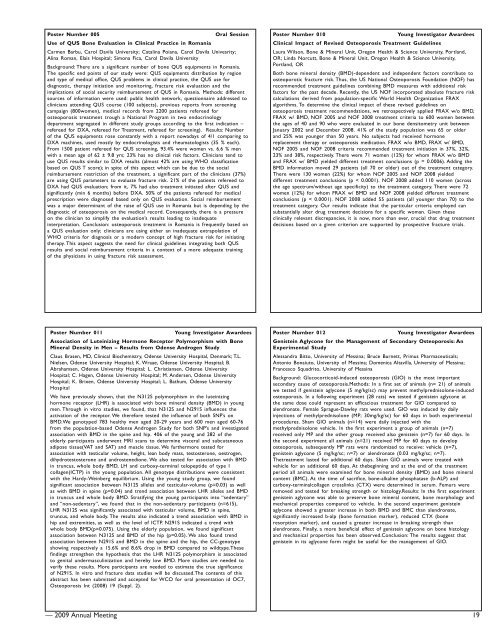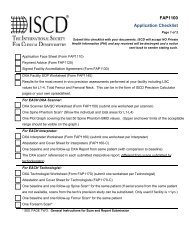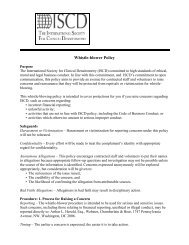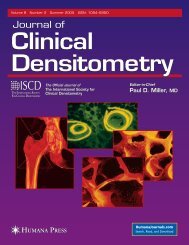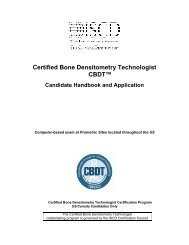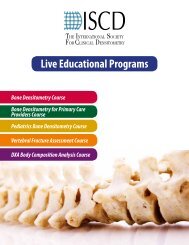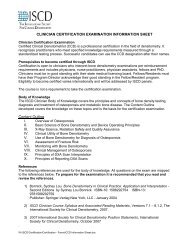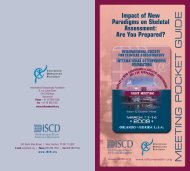Program Book and Abstracts - ISCD
Program Book and Abstracts - ISCD
Program Book and Abstracts - ISCD
You also want an ePaper? Increase the reach of your titles
YUMPU automatically turns print PDFs into web optimized ePapers that Google loves.
Poster Number 005<br />
Oral Session<br />
Use of QUS Bone Evaluation in Clinical Practice in Romania<br />
Carmen Barbu, Carol Davila University; Catalina Poiana, Carol Davila Univesrity;<br />
Alina Roman, Elais Hospital; Simona Fica, Carol Davila University<br />
Background: There are a significant number of bone QUS equipments in Romania.<br />
The specific end points of our study were: QUS equipments distribution by region<br />
<strong>and</strong> type of medical office, QUS problems in clinical practice, the QUS use for<br />
diagnostic, therapy initiation <strong>and</strong> monitoring, fracture risk evaluation <strong>and</strong> the<br />
implications of social security reimbursement of QUS in Romania. Methods: different<br />
sources of information were used: public health network, questionnaire addressed to<br />
clinicians attending QUS course (100 subjects), previous reports from screening<br />
campaign (800women), medical records from 2200 patients refereed for<br />
osteoporosis treatment trough a National <strong>Program</strong> in two endocrinology<br />
department segregated in different study groups according to the first indication –<br />
refereed for DXA, refereed for Treatment, refereed for screening). Results: Number<br />
of the QUS equipments rose constantly with a report nowadays of 4/1 comparing to<br />
DXA machines, used mostly by endocrinologists <strong>and</strong> rheumatologists (35 % each).<br />
From 1500 patient refereed for QUS screening, 93.4% were women vs. 6.6 % men<br />
with a mean age of 62 ± 9.8 yrs; 23% has no clinical risk factors. Clinicians tend to<br />
use QUS results similar to DXA results (almost 42% are using WHO classification<br />
based on QUS T score); in spite of this aspect which can be due to the social<br />
reimbursement restriction of the treatment, a significant part of the clinicians (37%)<br />
are using QUS parameters to evaluate fracture risk. 21% of the patients refereed to<br />
DXA had QUS evaluation; from it, 7% had also treatment initiated after QUS <strong>and</strong><br />
significantly (min 6 months) before DXA. 50% of the patients refereed for medical<br />
prescription were diagnosed based only on QUS evaluation. Social reimbursement<br />
was a major determinant of the raise of QUS use in Romania but is depending by the<br />
diagnostic of osteoporosis on the medical record. Consequently, there is a pressure<br />
on the clinician to simplify the evaluation’s results leading to inadequate<br />
interpretation. Conclusion: osteoporosis treatment in Romania is frequently based on<br />
a QUS evaluation only; clinicians are using either an inadequate extrapolation of<br />
WHO criteria for diagnosis or a modern concept of high fracture risk for initiating<br />
therapy. This aspect suggests the need for clinical guidelines integrating both QUS<br />
results <strong>and</strong> social reimbursement criteria in a context of a more adequate training<br />
of the physicians in using fracture risk assessment.<br />
Poster Number 010<br />
Young Investigator Awardees<br />
Clinical Impact of Revised Osteoporosis Treatment Guidelines<br />
Laura Wilson, Bone & Mineral Unit, Oregon Health & Science University, Portl<strong>and</strong>,<br />
OR; Linda Norcutt, Bone & Mineral Unit, Oregon Health & Science University,<br />
Portl<strong>and</strong>, OR<br />
Both bone mineral density (BMD)-dependent <strong>and</strong> independent factors contribute to<br />
osteoporotic fracture risk. Thus, the US National Osteoporosis Foundation (NOF) has<br />
recommended treatment guidelines combining BMD measures with additional risk<br />
factors for the past decade. Recently, the US NOF incorporated absolute fracture risk<br />
calculations derived from population-specific World Health Organization FRAX<br />
algorithms. To determine the clinical impact of these revised guidelines on<br />
osteoporosis treatment recommendations, we retrospectively applied FRAX w/o BMD,<br />
FRAX w/ BMD, NOF 2005 <strong>and</strong> NOF 2008 treatment criteria to 600 women between<br />
the ages of 40 <strong>and</strong> 90 who were evaluated in our bone densitometry unit between<br />
January 2002 <strong>and</strong> December 2008. 41% of the study population was 65 or older<br />
<strong>and</strong> 25% was younger than 50 years. No subjects had received hormone<br />
replacement therapy or osteoporosis medication. FRAX w/o BMD, FRAX w/ BMD,<br />
NOF 2005 <strong>and</strong> NOF 2008 criteria recommended treatment initiation in 37%, 32%,<br />
23% <strong>and</strong> 38%, respectively. There were 71 women (12%) for whom FRAX w/o BMD<br />
<strong>and</strong> FRAX w/ BMD yielded different treatment conclusions (p = 0.0006). Adding the<br />
BMD information moved 29 patients (all 70 or older) out of the treatment category.<br />
There were 130 women (22%) for whom NOF 2005 <strong>and</strong> NOF 2008 yielded<br />
different treatment conclusions (p < 0.0001). NOF 2008 added 110 women (across<br />
the age spectrum/without age specificity) to the treatment category. There were 72<br />
women (12%) for whom FRAX w/ BMD <strong>and</strong> NOF 2008 yielded different treatment<br />
conclusions (p < 0.0001). NOF 2008 added 55 patients (all younger than 70) to the<br />
treatment category. Our results indicate that the particular criteria employed can<br />
substantially alter drug treatment decisions for a specific woman. Given these<br />
clinically relevant discrepancies, it is now, more than ever, crucial that drug treatment<br />
decisions based on a given criterion are supported by prospective fracture trials.<br />
Poster Number 011<br />
Young Investigator Awardees<br />
Association of Luteinizing Hormone Receptor Polymorphism with Bone<br />
Mineral Density in Men – Results from Odense Androgen Study<br />
Claus Brasen, MD, Clinical Biochemistry, Odense University Hospital, Denmark; T.L.<br />
Nielsen, Odense University Hospital; K. Wraae, Odense University Hospital; B.<br />
Abrahamsen, Odense University Hospital; L. Christiansen, Odense University<br />
Hospital; C. Hagen, Odense University Hospital; M. Andersen, Odense University<br />
Hospital; K. Brixen, Odense University Hospital; L. Bathum, Odense University<br />
Hospital<br />
We have previously shown, that the N312S polymorphism in the luteinizing<br />
hormone receptor (LHR) is associated with bone mineral density (BMD) in young<br />
men. Through in vitro studies, we found, that N312S <strong>and</strong> N291S influences the<br />
activation of the receptor. We therefore tested the influence of both SNP’s on<br />
BMD.We genotyped 783 healthy men aged 20-29 years <strong>and</strong> 600 men aged 60-76<br />
from the population-based Odense Androgen Study for both SNP’s <strong>and</strong> investigated<br />
association with BMD in the spine <strong>and</strong> hip. 406 of the young <strong>and</strong> 282 of the<br />
elderly participants underwent MRI scans to determine visceral <strong>and</strong> subcutaneous<br />
adipose tissue(VAT <strong>and</strong> SAT) <strong>and</strong> muscle tissue. We furthermore tested for<br />
association with testicular volume, height, lean body mass, testosterone, oestrogen,<br />
dihydrotestosterone <strong>and</strong> <strong>and</strong>rostenedione. We also tested for association with BMD<br />
in truncus, whole body BMD, LH <strong>and</strong> carboxy-terminal telopeptide of type I<br />
collagen(ICTP) in the young population. All genotype distributions were consistent<br />
with the Hardy-Weinberg equilibrium. Using the young study group, we found<br />
significant association between N312S alleles <strong>and</strong> testicular-volume (p=0.03) as well<br />
as with BMD in spine (p=0.04) <strong>and</strong> trend association between LHR alleles <strong>and</strong> BMD<br />
in truncus <strong>and</strong> whole body BMD. Stratifying the young participants into “sedentary”<br />
<strong>and</strong> “non-sedentary”, we found that in the non-sedentary participants (n=615),<br />
LHR N312S was significantly associated with testicular volume, BMD in spine,<br />
truncus, <strong>and</strong> whole body. The results also indicated a trend association with BMD in<br />
hip <strong>and</strong> extremities, as well as the level of ICTP. N291S indicated a trend with<br />
whole body BMD(p=0.075). Using the elderly population, we found significant<br />
association between N312S <strong>and</strong> BMD of the hip (p=0.05). We also found trend<br />
association between N291S <strong>and</strong> BMD in the spine <strong>and</strong> the hip, the CC-genotype<br />
showing respectively a 15.6% <strong>and</strong> 8.6% drop in BMD compared to wildtype.These<br />
findings strengthen the hypothesis that the LHR N312S polymorphism is associated<br />
to genital undermasculinization <strong>and</strong> hereby low BMD. More studies are needed to<br />
verify these results. More participants are needed to estimate the true significance<br />
of N291S. In vitro <strong>and</strong> fracture data studies will be discussed.The contents of this<br />
abstract has been submitted <strong>and</strong> accepted for WCO for oral presentation id OC7,<br />
Osteoporosis Int (2008) 19 (Suppl. 2).<br />
Poster Number 012<br />
Young Investigator Awardees<br />
Genistein Aglycone for the Management of Secondary Osteoporosis: An<br />
Experimental Study<br />
Aless<strong>and</strong>ra Bitto, University of Messina; Bruce Burnett, Primus Pharmaceuticals;<br />
Antonio Bonaiuto, University of Messina; Domenica Altavilla, University of Messina;<br />
Francesco Squadrito, University of Messina<br />
Background: Glucocorticoid-induced osteoporosis (GIO) is the most important<br />
secondary cause of osteoporosis.Methods: In a first set of animals (n= 21) of animals<br />
we tested if genistein aglycone (5 mg/kg/sc) may prevent methylprednisolone-induced<br />
osteoporosis. In a following experiment (28 rats) we tested if genistein aglycone at<br />
the same dose could represent an efficacious treatment for GIO compared to<br />
alendronate. Female Sprague-Dawley rats were used. GIO was induced by daily<br />
injections of methylprednisolone (MP; 30mg/kg/sc) for 60 days in both experimental<br />
procedures. Sham GIO animals (n=14) were daily injected with the<br />
methylprednisolone vehicle. In the first experiment a group of animals (n=7)<br />
received only MP <strong>and</strong> the other group received also genistein (n=7) for 60 days. In<br />
the second experiment all animals (n=21) received MP for 60 days to develop<br />
osteoporosis, subsequently MP rats were r<strong>and</strong>omized to receive: vehicle (n=7),<br />
genistein aglycone (5 mg/kg/sc; n=7) or alendronate (0.03 mg/kg/sc; n=7).<br />
Thetreatment lasted for additional 60 days. Sham GIO animals were treated with<br />
vehicle for an additional 60 days. At thebeginning <strong>and</strong> at the end of the treatment<br />
period all animals were examined for bone mineral density (BMD) <strong>and</strong> bone mineral<br />
content (BMC). At the time of sacrifice, bone-alkaline phosphatase (b-ALP) <strong>and</strong><br />
carboxy-terminalcollagen crosslinks (CTX) were determined in serum. Femurs were<br />
removed <strong>and</strong> tested for breaking strength or histology.Results: In the first experiment<br />
genistein aglycone was able to preserve bone mineral content, bone morphology <strong>and</strong><br />
mechanical properties compared to vehicle. In the second experiment genistein<br />
aglycone showed a greater increase in both BMD <strong>and</strong> BMC than alendronate,<br />
significantly increased b-alp (bone formation marker), reduced CTX (bone<br />
resorption marker), <strong>and</strong> caused a greater increase in breaking strength than<br />
alendronate. Finally, a more beneficial effect of genistein aglycone on bone histology<br />
<strong>and</strong> mechanical properties has been observed.Conclusion: The results suggest that<br />
genistein in its aglycone form might be useful for the management of GIO.<br />
— 2009 Annual Meeting 19


